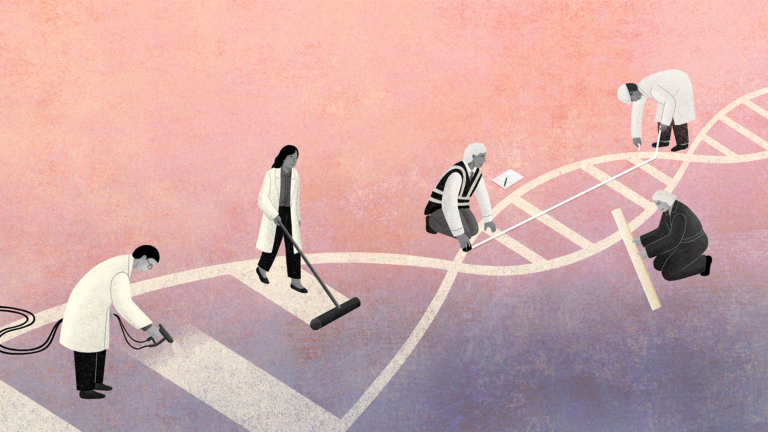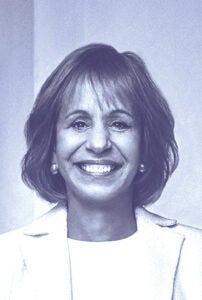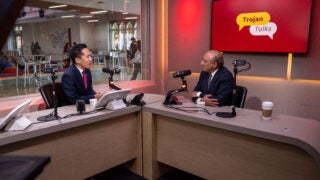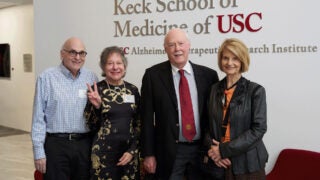
(Illustration/Sunnu Rebecca Choi)
Charting the future of health care at USC
Through the alignment of the medical system and health science schools in President Carol Folt’s Health Sciences 3.0 ‘moonshot,’ USC will meet the challenges and opportunities of an ever-evolving health landscape.
In April 2022, USC President Carol Folt gave her first in-person State of the University address at Bovard Auditorium. After two years of pandemic uncertainty, the USC community was ready to come together and hear Folt’s agenda for what lay ahead.
“With our unrivaled size, scale, breadth and excellence, we can become national leaders in access and belonging, in sustainability and in partnering with communities for health, safety, freedom and prosperity,” Folt said.
She went on to articulate her vision for establishing USC as the international standard-bearer for collaborative learning and discovery through what she dubbed “moonshots” — one of which was a major expansion of the university’s health sciences efforts.
“No other university has this constellation of resources and schools to create a healthier society for the future,” she added.
It was a clarion call. Folt, who declares USC to be the “school of schools,” added that with Trojans working across disciplines to drive innovation in health care, “the potential is limitless.”
Her ambitious plan has resonated throughout the faculty: “USC is exactly the place for an initiative like President Folt’s health care moonshot,” says Mark S. Humayun, University Professor of ophthalmology and biomedical engineering at the Keck School of Medicine of USC. “We can leverage the expertise of USC’s unique cross-disciplinary minds to really tackle the health care issues of today and into the future.”
Collaborate and create
Folt’s announcement marked an important first step in supercharging collaboration within USC’s five health schools and its academic medical system, Keck Medicine of USC. The initiative, dubbed the Health Sciences 3.0 moonshot, aims to catalyze team-based research and education to develop new models of care for the communities surrounding USC’s campuses. The moonshot will take advantage of the AI revolution and collaborative care to overcome the greatest challenge of health care — providing improved outcomes at an affordable price.

Even before the initiative’s announcement, Folt was already in motion, creating the Office of Health Affairs to facilitate cross-disciplinary and cross-school collaboration. In May 2021, she hired physician-scientist Steven Shapiro to lead that office as the first senior vice president for health affairs.
Shapiro previously served as president of University of Pittsburgh Medical Center health services, the largest academic health system in the United States. His mission at USC: to create an infrastructure to help the university’s health entities — which represent 65% of the university’s total research, 70% of total full-time faculty and 54% of full-time staff — work with each other and the university as a whole to develop these new models of care.
“We are also on the verge of understanding the molecular basis of disease with the opportunity to cure diseases that have plagued the world for centuries,” Shapiro says. “Indeed, we are about to enter another golden age of medicine.”
In addition to building interdepartmental partnerships around artificial intelligence, digital health and health technology, the office also creates incentives for this work, such as the Nemirovsky Engineering and Medicine Opportunity Prize, which supports early-stage research at the intersection of health sciences and engineering.
The university’s health enterprise includes four hospitals — Keck Hospital of USC, USC Norris Cancer Hospital, USC Verdugo Hills Hospital and USC Arcadia Hospital — more than 900 faculty physicians, and more than 100 unique clinics in Southern and Central California and Las Vegas.
“We are realizing the future of medicine with research-based inputs combined with AI, brilliant minds and compassionate caregivers to deliver tomorrow’s medicine today,” Shapiro says.
“With our unrivaled size, scale, breadth and excellence, we can become national leaders in access and belonging, in sustainability and in partnering with communities for health, safety, freedom and prosperity.”
USC President Carol Folt
A pioneer from the beginning
Ever since USC founded the region’s first medical school in 1885, the university has been a critical part of providing health care to the Los Angeles community, particularly its most vulnerable patients. Beyond training physicians in the newest, most advanced clinical interventions available, USC has pioneered new treatments for some of the most complex diseases.
Today, the USC Health Affairs office comprises the USC Suzanne Dworak-Peck School of Social Work, the Herman Ostrow School of Dentistry of USC, the USC Alfred E. Mann School of Pharmacy and Pharmaceutical Sciences, the USC Mrs. T.H. Chan Division of Occupational Science and Occupational Therapy, the USC Division of Biokinesiology and Physical Therapy, the USC Leonard Davis School of Gerontology, the Keck School of Medicine of USC, and the USC health system — Keck Medicine of USC.
Faculty from other schools, including the USC Dornsife College of Letters, Arts and Sciences, USC Price School of Public Policy, and the USC Viterbi School of Engineering, are intrinsically involved in research, education and programs that address the pressing health needs of our time.
The ‘school of schools’
While Trojans across schools have long collaborated, there was a limit to what researchers, scientists and clinicians could achieve within individual disciplines to spur discoveries that help patients live longer, healthier lives.
“The United States has been criticized for both the high cost of care and outcomes such as life expectancy, which have lagged behind our peer nations,” Shapiro says. In reality, he adds, only a small fraction of this cost is directly related to health care.
He points out that despite health issues such as homicide, suicide, drug addiction, and behaviors such as diet, exercise, sleep, smoking and significant health inequity, “There is no better place than the United States to care for the most complex acute health problems.”
Every school at USC, he says, is playing a role to improve health for all. “Never before have our physicians and scientists worked so closely together,” Shapiro says. “At USC, we are tackling the many factors to lead a life well-lived.”
In June 2023, for the first time, USC’s annual research expenditures surpassed $1 billion, including USC in an exclusive group of just 13 private universities in the country that can boast the same. A nationally recognized measure of a university’s innovation potential, the $1 billion included significant investments in Folt’s moonshots in computing, sustainability and health.
That huge number represents the breadth of research that Trojans are engaged in — from oncology to the onset of aging, to cardiac care, to AI in health care — all to tackle humanity’s biggest problems.
Ishwar K. Puri, senior vice president of the USC Office of Research and Innovation, calls USC’s interdisciplinary work in the health space the “backbone” of the entire university. “It allows us to leverage the strength of the university both within the health sciences schools and outside the health sciences schools,” Puri says.
For example, at the USC Institute for Addiction Science, faculty members across disciplines produce innovative and adaptable scientific evidence and educational programming to increase awareness, correct misperceptions, counteract stigma and inform policy on addiction. The institute is a partnership between the USC Suzanne Dworak-Peck School of Social Work, Keck School of Medicine of USC, and USC Mann School of Pharmacy and Pharmaceutical Sciences.
Another exciting example of an interdisciplinary feat involves the USC Information Sciences Institute — led by University Professor Shri Narayanan of USC Viterbi and involving other researchers from USC Viterbi, USC Dornsife, the Keck School of Medicine and the University of California, Los Angeles — where researchers are attempting to predict psychological health risk factors to support clinical screenings for issues such as depression and suicidal ideation.
In line with Folt’s vision of the university as an international standard-bearer for collaborative learning and discovery, USC researchers such as Arthur Toga and Paul M. Thompson at the Keck School of Medicine and the USC Mark and Mary Stevens Neuroimaging and Informatics Institute are discovering new ways to use neuroscience, mathematics, computer science and software engineering for brain research.
Likewise, University Professor Peter Kuhn of USC Dornsife works with experts in machine learning and artificial intelligence from USC Viterbi to analyze thousands of blood sample images from “liquid biopsies” to work toward better outcomes in cancer therapies. The minimally invasive alternative to tissue biopsies aids physicians in detecting and managing early- and late-stage cancers.
Diversity spurs new models of care
At almost 10 million people, Los Angeles County’s population is larger than that of 40 states and extremely diverse. Residents include people from more than 140 countries who speak a combined total of more than 200 languages. There is no ethnic majority, and more than one-third of residents are born outside the United States.
It’s a microcosm of the world — and what ails it.
Serving the communities around USC drives innovation, says Rodney B. Hanners, CEO of Keck Medicine of USC and president and CEO of the USC Health System.
“L.A.’s diverse population provides a rich foundation for science and research in tailoring leading-edge treatment and care to individual needs, whether it’s based on race, gender or other demographics,” Hanners says.
For example, roughly 60% of cancer patients in clinical trials at the USC Norris Comprehensive Cancer Center are from historically underrepresented populations. The center works with community organizations to connect patients who want to participate in clinical trials, which contributes to a wealth of varied perspectives and to closing the gap on health equity.
“At USC, we are tackling the many factors to lead a life well-lived.”
USC Senior Vice President for Health Affairs Steve Shapiro
Meeting patients where they are
The Office of Health Affairs is also working to transform health care by delivering exceptional team-based care, not just in a hospital setting, but increasingly in patients’ homes, in the community and in the streets.
One example is new research led by Keck Medicine of USC medical oncologist Jorge Nieva. In his work, Nieva is exploring the benefits patients experience when receiving cancer care at home combined with telemedicine appointments and remote monitoring. He is leading the first clinical trial to test at-home administration of immunotherapy in the treatment of non-small cell lung cancer, which could lay the foundation for the future of at-home cancer care.
Since the inception of the Keck School of Medicine of USC 140 years ago, USC has also collaborated with Los Angeles General Medical Center to provide the equitable and leading-edge care of its academic health center to surrounding communities.
USC patients have the highest case mix index (CMI) nationwide for acute care hospitals, partly because many other hospitals transfer their patients to Keck Hospital to care for cases too complex for them to handle. CMI is a metric that reflects the heterogeneity of the patients treated at the hospital and the complexity and severity of their cases.
In other examples, for the past 50 years, the Ostrow School has combined dental care with social services to address the oral health needs of L.A. communities holistically through mobile dental clinics, health fairs, screenings and educational programs.
Outside the U.S. military, the school boasts the world’s largest fleet of mobile clinics, which provides treatment to school-age children across Southern California. The school also operates stationary clinics where Angelenos need it the most, such as the Union Rescue Mission in downtown L.A.’s Skid Row.
Likewise, each year, students from the USC Suzanne Dworak-Peck School of Social Work contribute nearly 1 million hours of service to communities through internships. Students from USC Leonard Davis and USC’s occupational and physical therapy programs, among other programs from the health sciences schools, have also devoted their internship practicums to serving the needs of L.A.’s diverse communities for decades.
The university also boasts the largest street medicine program in the country. In addition to medical clinicians, the program’s interdisciplinary team brings together professionals from many of the health sciences schools, including dentists, occupational therapists, social workers and other experts dedicated to meeting unhoused Angelenos where they are.
And USC continues its long-standing relationship with Children’s Hospital Los Angeles (CHLA), through which USC physicians care for some of the most medically complex pediatric patients.
Building a culture of innovation
These programs illustrate one of USC’s biggest strengths: its approach to innovation. Puri says, “We move from discovery to life-saving therapy for patients.”
USC entities such as the Stevens Center for Innovation encourage entrepreneurship among researchers and practitioners by providing an avenue to commercialize discoveries.
The Keck School of Medicine of USC also has one of the nation’s highest rates of funding per investigator from the National Institutes of Health, highlighting the school’s prowess in advancing medical knowledge and funding novel discoveries. According to Shapiro, this means USC researchers are able to bring in more resources and have the wherewithal to form larger, multidimensional collaborative groups. This gives USC the agility to translate research into clinical therapies that benefit local and global communities.
“Our moonshots take advantage of this special time of computational AI-driven scientific progress,” Shapiro says. “We have an opportunity to understand and cure disease while delivering continuous, often digital, care to our patients wherever they are. This is how we will improve human health.”



